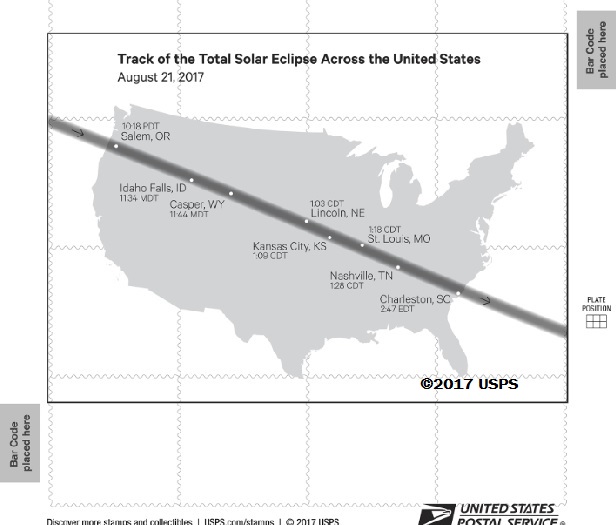#EclipseStamps. ©2017 USPS
WASHINGTON — Tomorrow (Jun 20), Jim Cochrane, Chief Customer and Marketing Officer of the United States Postal Service dedicates the first-of-its-kind Forever stamp which transforms the solar eclipse image into the Moon from the heat of a finger. The Total Eclipse of the Sun Forever stamp commemorates the upcoming Aug. 21 eclipse.
Cochrane will be joined by NASA and University of Wyoming officials, and astrophysicist Fred Espenak aka Mr. Eclipse at the June 20, 1:30 p.m. MT/3:30 p.m. ET First-Day-of-Issue ceremony, which will take place at the Art Museum of the University of Wyoming (UW) in Laramie. The University is celebrating the summer solstice on June 20. Prior to the event, visitors are encouraged to arrive at 11:30 a.m. to witness a unique architectural feature where a single beam of sunlight shines on a silver dollar embedded in the floor, which occurs at noon on the summer solstice in the UW Art Museum’s Rotunda Gallery.
The pane of 16 Forever stamps are available tomorrow at Post Office facilities nationwide and may be pre-ordered now at this link for delivery after June 20.
In addition to Espenak, scheduled to join Cochrane in the first-day-of-issue ceremony are NASA Astrophysicist Madhulika “Lika” Guthakurta; andUniversity of Wyoming Department of Physics and Astronomy Professor Chip Kobulnicky.
“With the release of these amazing stamps using thermochromic ink, we’ve provided an opportunity for people to experience their own personal solar eclipse every time they touch the stamps,” says Cochrane. “As evidenced by this stamp and other amazing innovations, the Postal Service is enabling a new generation to bridge the gap and tighten the connection between physical mail and the digital world.”
A total eclipse of the Sun occurs when the Moon completely blocks the visible solar disk from view, casting a shadow on Earth. The 70-mile-wide shadow path of the eclipse, known as the “path of totality,” will traverse the country diagonally, appearing first in Oregon (mid-morning local time) and exiting some 2,500 miles east and 90 minutes later off the coast of South Carolina (mid-afternoon local time) passing through portions of 14 states.
A total solar eclipse provides us with the only chance to see the Sun’s corona — its extended outer atmosphere — without specialized instruments. During the total phase of an eclipse, the corona appears as a gossamer white halo around the black disk of the Moon, resembling the petals of a flower reaching out into space.
Tens of millions of people in the United States hope to view this rare event, which has not been seen on the U.S. mainland since 1979. The eclipse will travel a narrow path across the entire country for the first time since 1918. The back of the stamp pane provides a map of the August 21 eclipse path and times it may appear in some locations. Visit NASA’s website to view detailed maps of the eclipse’s path.
This stamp image is a photograph taken by retired NASA astrophysicist Fred Espenak of Portal, AZ, who is considered by many to be the world’s leading authority on total solar eclipses with 27 under his belt. The photograph shows a total solar eclipse seen from Jalu, Libya, on March 29, 2006.
“I’m honored to have my images on this unique stamp. But more importantly, the stamp will spread the news about America’s great eclipse to many more people than I could ever reach,” said Espenak, who began collecting eclipse stamps after witnessing his first as a teenager. “A total eclipse of the Sun is simply the most beautiful, stunning and awe-inspiring astronomical event you can see with the naked eye — but you’ve got to be in the 70-mile-wide path of totality that runs across the nation from Oregon to South Carolina. So where will you be on August 21?”
“Having witnessed so many total eclipses myself, I know that two minutes inside the moon’s shadow could have a profound impact on the younger generation,” said Guhathakurta. “The Sun can be viewed safely with the unaided eye only during the few brief seconds or minutes of a total solar eclipse. Partial eclipses or partial phases of total solar eclipses are never safe to watch without solar eclipse glasses.”
Guthakurta recommended learning more about solar eclipse safety, educational and scientific information at eclipse2017.nasa.gov. NASA TV and NASA.gov will broadcast a live panel discussion and news conference starting at 1 p.m. ET Wed. June 21, from the Newseum in Washington, DC.
Share your experience on Social Media
Be creative and have with the stamps on social media using the hashtag #EclipseStamps.
- Take photos of friends, family, and children holding the stamps next to their faces while wearing solar eclipse safety glasses.
- Take before and after photos of the stamp pane with a group of friends or children placing their thumbs on the black disc of the eclipse to reveal the moon. It’s a great way to get kids into stamp collecting.
- Share past eclipse stories and plans of where you’ll be Aug. 21.
- On the day of the eclipse, take a photo of the map on the back of the stamp pane with either your finger pointed to your location, or write in the name of your location and draw an arrow to it. Try to include a recognizable landmark in the photo’s background. If possible include other eclipse watchers in the background.








 EastTexasRadio.com Powered by Ten Stations
EastTexasRadio.com Powered by Ten Stations






